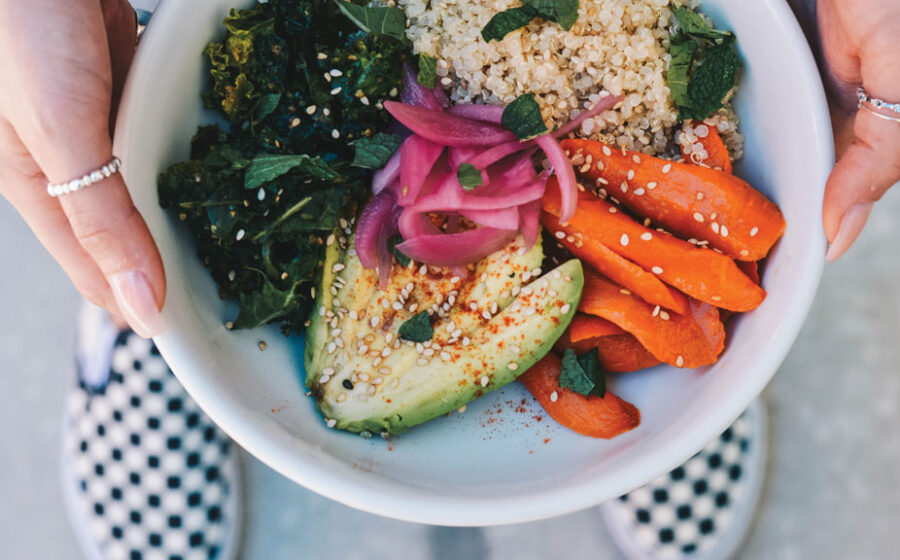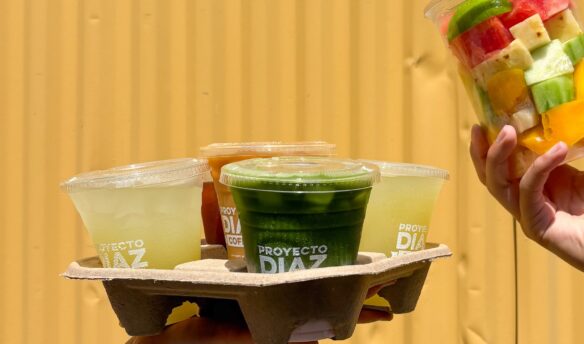[I]t’s easy to argue for developing a food menu: even the most straightforward offerings can raise ticket averages, encourage customers to linger longer, and help draw in crowds during otherwise slow lunchtime hours. Food menus are also a means of developing a brand and strengthening company core values through methods like highlighting sustainable ingredients, community partnerships, wacky names for dishes—the list goes on.
But the steps between brainstorming and executing a menu are rarely simple. From square-footage limitations to budget restrictions, there are many barriers to overcome on the road to a thriving food program. However, it doesn’t take a full kitchen or a culinary degree to get the job done. With some ingenuity and a mind for collaboration, the next level of café dining is easily within reach.
Big Dreams, Small Space
If you’re working with a convection oven and zero square footage, you have a couple of options:
- Stick with only coffee.
- Get creative with your space and ingredient repurposing.
- Partner with a local vendor.

For tiny spaces without the option of expansion, an easy way to add food offerings is by partnering with a vendor to bring in prepared items already packaged for sale or ready to be served with minimal preparation (e.g., heating in a convection oven).
Seattle’s Bread & Bone is a specialty catering company helping cafés serve excellent food. They believe cafés should pay the same amount of effort and attention to coffee and food.
Co-owners Nick and Andi Springer are food and beverage industry veterans—Nick has a background in fine dining, and Andi managed coffee shops. The Springers mobilized Bread & Bone after noticing the cold cases at some of their local cafés were seriously lacking. For the last year, they have been supplying sandwiches, wraps, and custom items to local cafés: Anchorhead Coffee, Fika House Kafe, and Victrola Coffee, to name a few.

Most of their products highlight local ingredients and are made in-house, including a slow-cooked tomato jam and mustards. Goat cheese comes directly from Yarmuth Farm in Darrington, Washington, and beef comes from Niman Ranch, an eleven-acre ranch in a small coastal town north of San Francisco that raises beef using humane and sustainable husbandry methods.
Anchorhead Coffee chose to partner with Bread & Bone after realizing an expansion into lunch would be too difficult to accommodate in-house. “We were looking for quality lunch items, but we couldn’t make them ourselves,” says co-owner Jake Paulson. “And Bread & Bone has a great program where they donate what we don’t sell, and it’s a win-win.”
San Diego’s Hawthorn Coffee also decided to pursue the route of a vendor partnership. Examining their 800-square-foot space, owner Dylan Redmond says they knew a modest menu incorporating dishes prepped outside the café was their best bet. Hawthorn partners with Paraná Empanadas, a local favorite that delivers fresh empanadas three times a week (Paraná sets a schedule based on the needs of their partners).
The rest of Hawthorn’s menu is simple enough to be prepped with minimal cooking and storage requirements: a toast menu with five options (including the mouthwatering GOAT—goat cheese, olive oil, and apricot preserves on local Bread & Cie sourdough) and a couple of granola and yogurt options. “Doing food this way makes sense for us,” Redmond says. “We want to provide food options, but we have no room for a big kitchen expansion.”
Takeaways: Good candidates for ready-made food vendors:
- Cafés with under 500 square feet of space.
- Shops without any equipment for food prep (and no budget to add any).
- Staff who want to keep hands-on coffee and not food.
Hire an Expert
Suppose you have the space and budget to accommodate a robust array of kitchen equipment (think commercial-adjacent). In that case, your options for menu development are essentially endless, including bringing in a chef to create your menu.
Miami’s OTL (an abbreviation for Out to Lunch) is a café and restaurant collaboration between Miami’s David Grutman and New York’s the Smile. To develop an approachable menu that would resonate with its Miami customer base, OTL brought in Rachel Nichols and Rosanne Smith, head chef, and pastry chef, respectively, at the Smile. Nichols and Smith developed a menu for OTL that a local Miami chef could then execute.
The original plan was for OTL to be specialty coffee forward, with some food, but positive customer response to the food menu shifted their intentions. OTL still offers specialty coffee, but the café is becoming more known for its food. “People love the food so much, and it became a key restaurant element. It was a good surprise,” Smith says.
The menu includes items that are expertly crafted without being overly fussy. The chefs’ pick? The super seed butter toast. Nichols says they developed the dish as an homage to their love of food that’s healthy yet balanced. “It’s purposefully on a decadent piece of locally made brioche toast slathered with butter,” she says.
Takeaways: Call reinforcements if you have a robust kitchen space, connections with an established chef, or the budget to support a consult.
Collaborate
If hiring a chef isn’t suitable for your business, try partnering with a chef interested in the coffee industry. Chicago’s Hero Coffee Bar opened to be a place where food and coffee were both executed well and given equal precedence. The concept came to life when owner Craig Alexander partnered with Brian Tubolino, founder of Dining Consultants International, who has over a decade of experience in the food industry.
Alexander’s experience and obsession with coffee perfectly complement Tubolino’s culinary experience and expertise, and their plans took off. Hero opened, boasting a kitchen equipped with a refrigerated prep table (think Subway, the global sandwich chain), conveyor toaster, a tabletop griddle, and a coffee bar complete with a three-group La Marzocco Linea and Hario V60 drippers.
Three years later, Hero has three locations around the city, with more planned to open over the next year. Regular customers love what Alexander calls “feel-good food,” breakfast sandwiches like the Usual Suspects—a bacon, egg, cheese, and cream cheese sandwich on a bagel—and lunch combinations, all served on house-made bagels and breads. “Our philosophy is easy: keep it simple, keep it tasty,” Alexander says.
As Hero Coffee Bar grows, it’s adopting a hybrid model. In the Bucktown neighborhood, the newest location features a full-scale commercial kitchen. The Bucktown location makes food for its patrons and serves as a commissary kitchen for the two other Hero locations operating with only simple tools: a six-foot stainless steel table, refrigerator, conveyor toaster, countertop griddle, and sandwich press.
Takeaways: Bring on a partner if you’re just getting started or gearing up for a serious build-out. You can make the numbers work and share a vision with your prospective partner.
Rent-a-Kitchen
Consider a shared kitchen space when you have the know-how to prepare quality food, but space is an issue. Commissary kitchens are an excellent way to save money—many kitchens rent by the hour—while offering your customers a wide range of sandwiches, wraps, salads, sweet treats, and more.
Los Angeles’s Nice Coffee rents space at a nearby commissary kitchen to supply its daily sandwiches, donuts, and famous Friday breakfast burritos. The inspiration for these burritos came from the breakfast taco scene in Austin, Texas. According to owner Tyler Wells (also of Hot Fat Donuts and previously of Handsome Coffee Roasters), breakfast tacos “are good fresh, but much better warmed.”
And that’s how they do it at Nice. Burritos are held in a warming tray “like an old-school street vendor.” The success of these burritos is leading to more opportunities—Nice is in the beta-testing phase of wholesaling to local cafés, supplying donuts and sandwiches to ten spots in town. “It’s hard to find a good grab-and-go sandwich in LA. We could reasonably be a food supplier for the LA coffee scene,” Wells says.
Utilize your friendly neighborhood commissary kitchen if you have culinary skills to spare but no means to expand your kitchen.
Rachel Sandstrom Morrison is Fresh Cup’s associate editor.
This article was originally published on July 5, 2017 and has been updated to meet Fresh Cup’s current editorial standards.






















